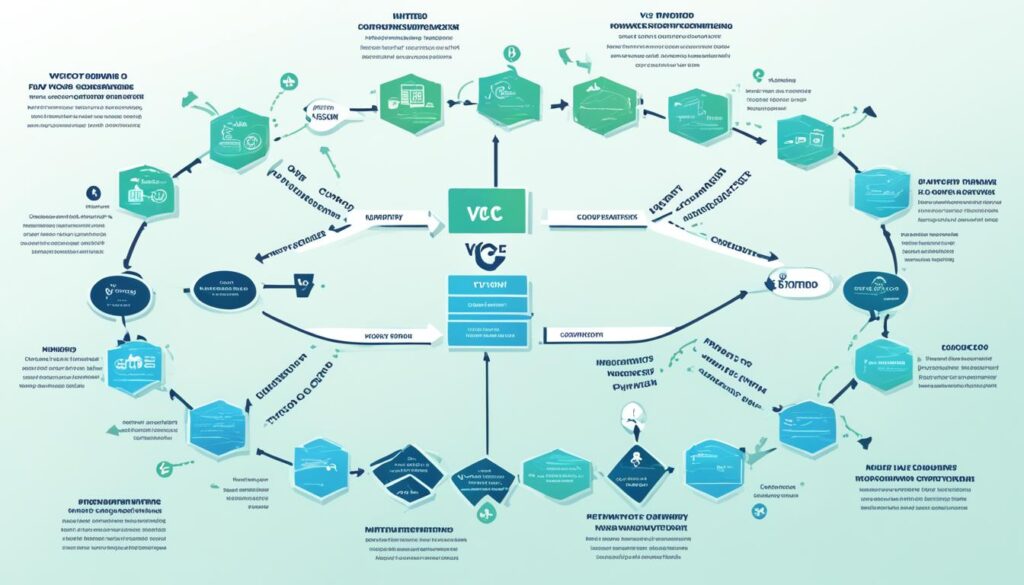In the fast-paced world of startups and innovation, venture capital (VC) firms play a crucial role in fueling growth and driving progress. But have you ever wondered how these VC firms generate their own revenue? The answer lies in their unique business model, which revolves around two primary sources: management fees and carried interest (carry).
VC firms raise money from a diverse pool of investors, known as limited partners (LPs), which include high-net-worth individuals, investment banks, insurance companies, endowments, and other financial institutions. The general partners (GPs) of the VC firm also commit their own capital to the fund, typically 1-2%, to align their interests with the LPs. This “skin in the game” ensures that the VC firm’s incentives are closely tied to the success of the investments.
But the real magic happens in how VC firms leverage these funds to generate returns. Management fees, typically around 2% of the total fund size, cover the firm’s operational expenses, such as salaries, overhead, and portfolio management. The more significant source of revenue, however, comes from the carried interest, which is a percentage (usually 20%) of the profits generated from successful investments.
The intricate balance between management fees and carried interest is what drives the VC firm’s business model and shapes their investment strategies. Understanding this dynamic is crucial for startups seeking venture funding, as it helps them align their growth potential and exit expectations with the VC firm’s need for outsized returns.
So, the next time you hear about a VC firm’s investment activities, remember that their success isn’t just about finding the next unicorn – it’s also about mastering the delicate art of revenue generation, which is the lifeblood of their industry.
Key Takeaways
- VC firms generate revenue through two primary sources: management fees and carried interest (carry).
- Management fees are a recurring charge, typically 2% of the total fund size, used to cover the firm’s operating expenses.
- Carried interest is a share (usually 20%) of the profits generated from successful investments, which is distributed to the VC firm’s partners.
- VC firms raise funds from a diverse pool of investors, known as limited partners (LPs), as well as committing their own capital to the fund.
- Understanding the VC firm’s revenue model is crucial for startups seeking venture funding, as it helps align their growth expectations with the VC’s investment thesis.
Understanding Venture Capital
Venture capital is a specialized form of private equity that focuses on investing in young, dynamic companies with significant growth potential. Unlike traditional financing options like bank loans or public markets, venture capital typically involves exchanging equity in the company for the investment, aligning the interests of the venture capitalists (VCs) with the startup’s success.
What is Venture Capital?
Venture capital is a subset of the broader private equity industry, but with a distinct focus on early-stage, high-risk, high-reward investments in innovative startups. VCs seek out companies with the potential for rapid growth and outsized returns, providing them with not just financial capital, but also strategic guidance, industry expertise, and valuable networking opportunities.
The Role of Venture Capitalists
Venture capitalists play a multifaceted role in supporting the growth and development of their portfolio companies. Beyond providing the necessary funding, they often act as strategic advisors, offering valuable insights and connections to help startups navigate the complexities of scaling their business. VCs leverage their industry knowledge, entrepreneurial experience, and extensive networks to mentor founders, connect them with potential partners and customers, and help them overcome the challenges of building a successful venture.
Impact on Startups and the Economy
Venture capital funding serves as a crucial catalyst for innovation and economic growth. By enabling startups to access the capital and resources they need to develop and commercialize new technologies, solutions, and business models, venture capital investment drives the creation of jobs, the introduction of disruptive innovations, and the overall advancement of the economy. The high-risk, high-reward nature of venture capital financing supports the entrepreneurial spirit and fosters an environment where bold ideas can thrive and transform industries.

Sources of VC Firm Revenue
Venture capital (VC) firms generate revenue through two primary sources: management fees and carried interest (carry). Management fees are a recurring charge, typically 2% of the total fund size, used to cover the firm’s operating expenses, such as salaries, overhead, and portfolio management. Carried interest, on the other hand, is a share of the profits (usually 20%) generated from successful investments that are distributed to the VC firm’s partners.
The structure and lifecycle of VC funds, including the investment period, exit strategies, and fund duration, play a key role in how VC firms get their money. The investment period, typically the first 3-5 years, is when VC firms actively deploy capital into their portfolio companies. After this period, the focus shifts to managing the existing investments and facilitating successful exits, either through acquisitions or initial public offerings (IPOs).
The limited duration of VC funds, usually around 10 years, creates a sense of urgency for VC firms to identify and support the most promising startups, as they need to generate returns within the fund’s lifecycle. This pressure to achieve liquidity events shapes the VC firm’s investment and portfolio management strategies, as they seek to maximize the chances of generating outsized returns for their investors.

Management Fees
The management fees charged by venture capital (VC) firms are a crucial component of their revenue model. These fees, typically calculated as a percentage of the total fund size, provide a stable income stream to cover the firm’s operational expenses, such as salaries, overhead, and portfolio management.
Calculating Management Fees
VC firms generally charge management fees in the range of 2% of the total fund size, which is the amount of capital committed by their limited partners (LPs). These fees are collected annually, with the structure often involving a gradual decrease over the fund’s lifecycle. During the active investment period, when the VC firm is actively deploying capital, the management fees are typically higher. As the fund matures and the focus shifts to managing the existing portfolio, the fees tend to decrease.
Impact on Fund Returns
While the management fees provide a stable income stream for VC firms, they can also have a direct impact on the fund’s overall returns. By reducing the amount of capital available for investments, the management fees lower the fund’s potential returns. This creates a hurdle rate that portfolio companies must exceed in order to generate carried interest, or a share of the profits, for the VC firm. The management fee structure, in conjunction with the VC firm’s need to deliver attractive returns to its LPs, shapes its investment strategies and the types of startups it targets.

Carried Interest (Carry)
The
carried interest
, or “carry,” represents the VC firm’s share of the profits generated from successful investments in its portfolio companies. This is typically structured as a 20% stake in the fund’s gains, with the remaining 80% going to the limited partners (LPs). The
carry
provides a powerful incentive for VC firms to maximize the returns on their investments, as their compensation is directly tied to the fund’s performance.
Defining Carried Interest
The carried interest is the portion of the investment profits that the VC firm’s general partners (GPs) receive as compensation for their management of the fund. This percentage, typically 20%, is a key component of the VC firm’s revenue model and helps to align the interests of the GPs with those of the LPs, who provide the majority of the capital for the fund.
Carry Distribution
Within the VC firm, the carry is often distributed among the partners, with the majority going to the senior partners and a smaller percentage shared among other employees. This helps to align the interests of the VC firm’s staff and motivate them to contribute to the success of the portfolio companies. By tying a significant portion of their compensation to the overall profits of the VC firm, the partners are incentivized to make prudent investment decisions and provide strategic guidance to the startups they’ve funded.

How do VC firms get their money?
VC firms raise the majority of their funds from institutional investors, high-net-worth individuals, and other financial entities known as limited partners (LPs). These LPs provide the vast majority (typically 99%) of the capital in a VC fund, while the general partners (GPs) of the VC firm commit their own capital, usually around 1-2% of the total fund size.
Fundraising from Limited Partners
The fundraising process involves the VC firm pitching its investment strategy, track record, and management team to potential LPs, who then decide whether to commit capital to the fund. This “skin in the game” from the GPs helps to align their interests with the LPs, as the GPs are incentivized to make prudent investment decisions that will generate strong returns for the fund.
General Partner Commitments
The VC firm’s general partners (GPs) typically contribute around 1-2% of the total fund size, providing a meaningful personal stake in the fund’s performance. This alignment of interests between the GPs and the LPs is a crucial factor in the VC fundraising process, as it demonstrates the firm’s commitment to making successful investments that will generate attractive returns for all investors.

VC Investment Strategies
VC firms employ various investment strategies to generate superior returns for their funds. One key strategy is to focus on specific industries or sectors where they have deep expertise and connections, allowing them to identify the most promising VC investment strategies. This industry focus enables VC firms to leverage their knowledge and networks to source and evaluate the most promising opportunities within their areas of competence.
Industry Focus
VC firms often specialize in certain industries or verticals, such as technology, healthcare, or renewable energy. By developing a deep understanding of the dynamics, trends, and growth potential within these industries, VC firms can more effectively identify and support the most innovative and disruptive startups. This industry focus allows VC firms to provide valuable strategic guidance and operational support to their portfolio companies, enhancing the likelihood of their success.
Risk Minimization
In addition to industry focus, VC firms also prioritize risk management as a key aspect of their investment strategies. They strive to invest in industries and companies that are more “competitively forgiving” than the broader market, meaning they are less susceptible to intense competition and disruption. This focus on risk-adjusted returns, combined with a diversified portfolio approach, helps VC firms navigate the inherent volatility of early-stage startups and maximize the likelihood of generating outsized returns.
Portfolio diversification is another crucial element of VC investment strategies, as it allows firms to spread their risk across multiple promising startups. By investing in a diverse range of competitively forgiving industries, VC firms can improve their chances of achieving at least a few “home run” investments that can offset the losses from other portfolio companies.

Fund Structure and Lifecycle
Venture capital (VC) funds are typically structured as closed-end investment vehicles with a defined lifespan, usually around 10 years. This limited fund duration creates a sense of urgency for VC firms to identify and support the most promising startups, as they need to generate returns within the fund’s lifecycle.
Investment Period
During the initial investment period, typically the first 3-5 years, VC firms actively deploy capital into their portfolio companies. A $75M fund with three General Partners that makes 15 investments would allocate around $5M for each company in the portfolio.
Exit Strategies
After the initial investment period, the focus shifts to managing the existing investments and facilitating successful exits, either through acquisitions or initial public offerings (IPOs). This pressure to achieve liquidity events shapes the VC firm’s portfolio management strategies, as they seek to maximize the chances of generating outsized returns for their investors.
To summarize the key points about VC fund structure and lifecycle:
| Metric | Typical Range |
|---|---|
| Fund Lifespan | 10 years, with possible 2-3 year extensions |
| Investment Period | 3-5 years |
| Initial Investment per Company | Approximately 30% of expected total investment |
| Target Ownership Range | 15-25% of each portfolio company |
| Portfolio Build-out Period | 1.5 to 3 years after fund launch |
The limited duration of VC funds creates a sense of urgency for firms to identify and support the most promising startups, as they need to generate returns within the fund’s lifecycle. This pressure to achieve liquidity events shapes the VC firm’s investment and portfolio management strategies.

The Math for Founders
From the perspective of startup founders seeking VC funding, it’s crucial to understand the VC firm’s investment thesis and return expectations. VC firms typically need to generate 3-10x returns on their investments to deliver attractive overall fund-level returns, given the inherent risk of early-stage startups.
Return Expectations
This means founders should expect VC investors to push for outsized growth and valuations, as they are primarily targeting a small number of “home run” investments that can offset the losses from other portfolio companies. The VC’s focus on these outlier returns, driven by a small number of highly successful investments, shapes their investment strategies and interactions with startup founders.
Outlier Returns
Founders should be prepared to align with the VC’s need for significant growth and returns to meet the fund’s hurdle rate and generate carried interest for the VC firm. This focus on risk-adjusted returns and portfolio diversification is crucial for VC firms to deliver the unicorn investments that can drive their overall fund performance.

VC Firm Economics
The overall economics of a VC firm are driven by the combination of management fees and carried interest (carry) generated from their investment funds. Management fees provide a steady source of revenue to cover the firm’s operating expenses, such as salaries, overhead, and portfolio management. However, the more significant source of profits for the VC firm comes from the carry, which is a percentage of the profits earned from successful investments.
Management Company Profits
As VC firms manage multiple funds simultaneously, the accumulated management fees and carried interest from each fund can result in substantial profits for the management company and its partners. The ability to generate consistent, high-performing exits that deliver outsized returns is crucial for VC firms to maintain their competitive edge and continue raising capital from limited partners.
Capital Gains from Exits
The capital gains generated from successful exits, such as acquisitions or initial public offerings (IPOs), represent a significant source of revenue for VC firms. These exit events not only provide returns to the limited partners but also generate substantial profits for the VC firm’s management company and its partners through the carried interest mechanism. By consistently delivering high-performing fund results, VC firms can maintain their reputation and continue raising capital from investors seeking to participate in the growth of innovative startups.

Myths and Realities
The popular perception of venture capitalists as risk-taking, hands-on operating experts is largely a relic of an earlier era. Today’s VC firms have evolved to become more akin to specialized bankers, focused on managing a diversified portfolio of investments to generate consistent returns. While some VC partners may have prior operating experience, the reality is that the average VC partner spends less than two hours per week on any given portfolio company, due to the demands of managing a typical portfolio of 10 or more investments.
Hands-On Operating Experience
Contrary to the popular belief, today’s VC industry myths suggest that venture capitalists are no longer the hands-on, risk-taking experts of the past. In reality, VC partners often spend minimal time directly engaged with the day-to-day operations of their portfolio companies, focusing instead on investment strategies and portfolio management to deliver consistent, superior returns.
Risk-Taking Mentality
The modern VC firm’s investment strategies are also more risk-averse, prioritizing investments in “competitively forgiving” industries over pure risk-taking. Venture capitalists are now more akin to specialized bankers, carefully managing a diversified portfolio to earn consistently superior returns on inherently risky investments. Understanding these myths and realities is crucial for entrepreneurs seeking VC funding and aligning their expectations with the VC’s approach.
Advice for Entrepreneurs
For entrepreneurs seeking VC funding, it’s essential to understand the VC firm’s motivations and investment thesis. Aligning your startup’s growth potential and exit strategy with the VC’s need for outsized returns is crucial. Be prepared to demonstrate how your business can deliver the 10x or greater returns that VC firms typically target.
Additionally, be mindful of the VC firm’s management fee structure and its impact on the fund’s overall returns. Ensure that your expectations around the VC’s hands-on involvement and operating expertise match the realities of their portfolio management approach. By understanding the VC firm’s economics and investment strategies, entrepreneurs can better navigate the VC fundraising process and build a mutually beneficial partnership.
To manage expectations and ensure investor alignment, it’s crucial for entrepreneurs to recognize that today’s venture capitalists are more akin to conservative bankers than the risk-takers of the past. By aligning your startup funding needs with the VC firm’s investment thesis, you can increase your chances of securing the capital and strategic support required to drive your business forward.
Conclusion
In the dynamic world of venture capital, understanding how VC firms generate their revenue is crucial for entrepreneurs seeking funding. VC firms have two primary sources of income: management fees and carried interest (carry). While management fees provide a steady source of revenue to cover operational expenses, the more significant profits come from the carry – the firm’s share of the gains from successful investments.
The management fee structure and its impact on fund returns, as well as the VC firm’s need to generate outsized returns to deliver carry, shape their investment strategies and interactions with founders. Entrepreneurs seeking VC funding must align their growth potential and exit expectations with the VC firm’s economics, navigating the fundraising process and building a mutually beneficial partnership.
Ultimately, the venture capital ecosystem plays a vital role in driving innovation and economic growth. By recognizing the realities of how VC firms operate, both startups and investors can better navigate the complexities of the venture capital landscape and unlock the full potential of their collaborative efforts. The key lies in aligning expectations, understanding motivations, and embracing the unique dynamics that define the VC industry.
